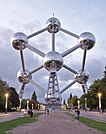
Brussels
Federal region of Belgium, including the City of Brussels / From Wikipedia, the free encyclopedia
Dear Wikiwand AI, let's keep it short by simply answering these key questions:
Can you list the top facts and stats about Brussels?
Summarize this article for a 10 year old
Brussels (French: Bruxelles, pronounced [bʁysɛl] ⓘ or [bʁyksɛl] ⓘ; Dutch: Brussel [ˈbrʏsəl] ⓘ), officially the Brussels-Capital Region[12][13] (French: Région de Bruxelles-Capitale;[lower-alpha 1] Dutch: Brussels Hoofdstedelijk Gewest),[lower-alpha 2] is a region of Belgium comprising 19 municipalities, including the City of Brussels, which is the capital of Belgium.[14] The Brussels-Capital Region is located in the central portion of the country and is a part of both the French Community of Belgium[15] and the Flemish Community,[16] but is separate from the Flemish Region (within which it forms an enclave) and the Walloon Region, located less than 4 kilometres (2.5 mi) to the south.[17][18] Historically Dutch-speaking, Brussels saw a language shift to French from the late 19th century.[19] Nowadays, the Brussels-Capital Region is officially bilingual in French and Dutch,[20][21] although French is the majority language and lingua franca.[22] Brussels is also increasingly becoming multilingual. English is spoken widely and many migrants and expatriates speak other languages as well.[22][23]
Brussels grew from a small rural settlement on the river Senne to become an important city-region in Europe. Since the end of the Second World War, it has been a major centre for international politics and home to numerous international organisations, politicians, diplomats and civil servants.[24] Brussels is the de facto capital of the European Union, as it hosts a number of principal EU institutions, including its administrative-legislative, executive-political, and legislative branches (though the judicial branch is located in Luxembourg, and the European Parliament meets for a minority of the year in Strasbourg).[1][25][lower-alpha 3] Because of this, its name is sometimes used metonymically to describe the EU and its institutions.[26][27] The secretariat of the Benelux and the headquarters of NATO are also located in Brussels.[28][29]
Brussels is the most densely populated region in Belgium, and although it has the highest GDP per capita,[30] it has the lowest available income per household.[31] The Brussels Region covers 162 km2 (63 sq mi) and has a population of over 1.2 million.[32] Its five times larger metropolitan area comprises over 2.5 million people, which makes it the largest in Belgium.[33][34][35] It is also part of a large conurbation extending towards the cities of Ghent, Antwerp, and Leuven, known as the Flemish Diamond, as well as the province of Walloon Brabant, in total home to over 5 million people.[36] As Belgium's economic capital and a top financial centre in Western Europe with Euronext Brussels, Brussels is classified as an Alpha global city.[37] It is also a national and international hub for rail, road and air traffic,[38] and is sometimes considered, together with Belgium, as Europe's geographic, economic and cultural crossroads.[39][40][41] The Brussels Metro is the only rapid transit system in Belgium. In addition, both its airport and railway stations are the largest and busiest in the country.[42][43]
Brussels is known for its cuisine and gastronomic offer (including its local waffle, its chocolate, its French fries and its numerous types of beers),[44] as well as its historical and architectural landmarks; some of them are registered as UNESCO World Heritage Sites.[45] Principal attractions include its historic Grand-Place/Grote Markt (main square), Manneken Pis, the Atomium, and cultural institutions such as La Monnaie/De Munt and the Museums of Art and History. Due to its long tradition of Belgian comics, Brussels is also hailed as a capital of the comic strip.[3][46]










